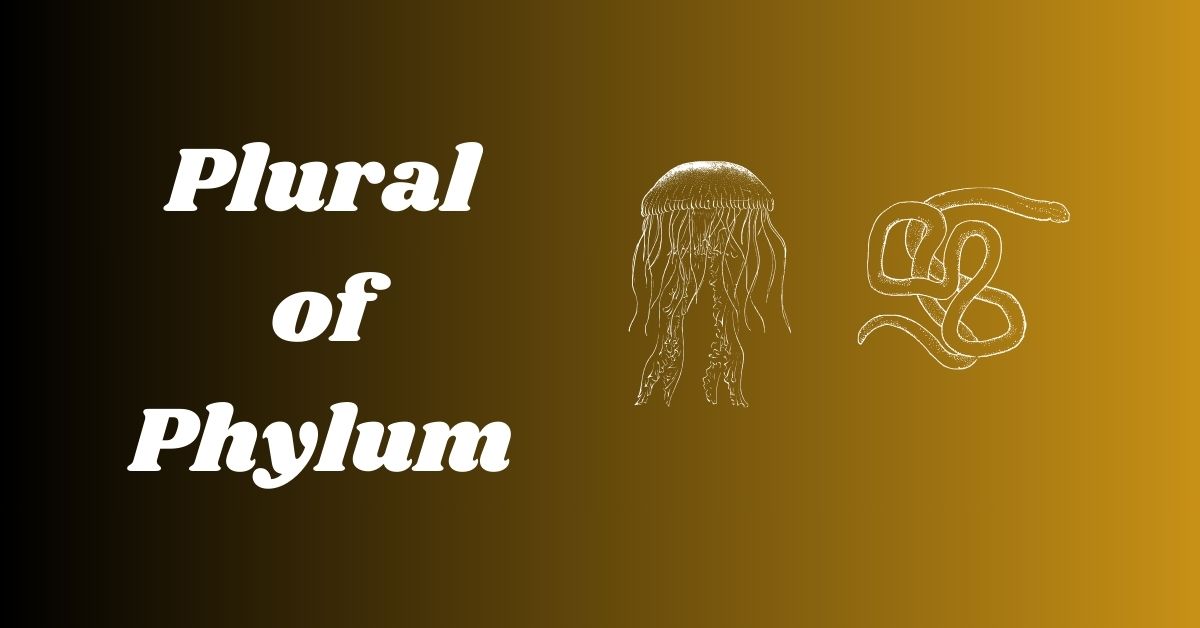Plural of Phylum is a topic that often confuses people, especially when discussing scientific terms in biological classification. The correct plural form of phylum is phyla, while the term phylums is considered nonstandard and informal.
This distinction arises from the rules of Latin pluralization, which govern many words used in taxonomy and scientific terminology. Understanding these rules is essential for anyone studying species classification, organism categories, or the broader taxonomic hierarchy.
In this article, we’ll explore the origins of the word “phylum,” its proper usage in both singular and plural forms, and how it fits into the larger framework of evolutionary biology and classification systems.
Quick Summary
The Plural of Phylum often raises questions, particularly among those studying biological classification. The correct plural form is phyla, derived from Latin rules, while phylums is considered informal and nonstandard.
Understanding this distinction is vital for clear communication in scientific discussions. This article will clarify the usage of “phylum” and “phyla,” exploring their meanings, origins, and roles within the broader context of taxonomy and evolutionary biology.
Understanding Phyla or Phylums

In the realm of scientific terms, “phylum” refers to a major taxonomic category that ranks above class and below kingdom in the taxonomic hierarchy. Each phylum groups together organisms that share significant characteristics.
For example, the phylum Chordata includes all vertebrates, while the phylum Arthropoda encompasses insects, arachnids, and crustaceans. When we refer to more than one phylum, we correctly use “phyla.” The term “phylums,” while used informally by some, does not adhere to standard grammatical rules for Latin-derived words.
Phylum as a Singular Noun in Example Sentences
Using “phylum” in its singular form is straightforward. For instance, one might say, “The phylum Chordata includes all vertebrates.” This sentence highlights how “phylum” categorizes a specific group within the larger classification system.
Another example could be, “Each phylum exhibits unique characteristics,” emphasizing the diversity found within different phyla. Lastly, consider this sentence: “A new phylum was discovered last year,” which showcases how ongoing research continues to expand our understanding of life’s classification.
Phylum as a Plural Noun in Example Sentences
When discussing multiple groups, we shift to using “phyla.” For example, “The animal kingdom contains multiple phyla,” illustrates how various groups exist within a larger context. Another sentence could read, “Scientists study different phyla to understand evolution,” which emphasizes the importance of these classifications in evolutionary biology.
Lastly, one might say, “Each phyla has distinct morphological traits,” showcasing how different groups can be characterized by unique features.
Origins of the Word “Phylum”
In 1868, the term “phylum” was coined by French naturalist Georges Cuvier to describe a primary division of the plant or animal kingdom, representing a genetically related tribe or race of organisms.
Derived from the Greek word “phylon,” meaning “race” or “stock,” it relates to “phylē,” which translates to “tribe” or “clan.” This classification level sits below kingdom and above class in the taxonomic hierarchy, helping organize the vast diversity of life into meaningful categories.
What is a Phylum?

In biological taxonomy, a phylum represents a significant level of organization within the classification of life. It serves as a bridge between broad categories like kingdom and more specific ones like class.
For instance, under the kingdom Animalia, you find various phyla such as Chordata (vertebrates) and Arthropoda (invertebrates). Each phylum contains organisms that share fundamental structural features and genetic similarities.
Plural of Phylum
The correct plural form of “phylum” is indeed phyla. While some may use “phylums,” this does not conform to standard linguistic patterns derived from Latin grammar rules. The distinction lies in how words ending in “-um” typically transform into their plural forms by changing “-um” to “-a.”
Synonyms of Phylum
To further enrich our understanding of biological classification, here are few synonyms related to “phylum“:
- Division
- Taxon
- Category
- Group
- Class
- Family
- Order
- Genus
- Species
- Subdivision
These terms help describe various levels within the broader scope of organism classification.
Phyla Definition

In biology, a phylum (plural: phyla) is a major taxonomic rank that categorizes organisms based on shared characteristics and evolutionary relationships. Positioned below the kingdom and above the class in the taxonomic hierarchy, phyla help organize biological diversity.
For example, the animal kingdom contains approximately 31 recognized phyla, such as Chordata (vertebrates) and Arthropoda (invertebrates). This classification system provides a structured way to study and understand the vast array of life forms on Earth.
Side by Side Comparison “Phyla vs Phylums”
To clarify further, here’s a simple comparison table:
| Term | Correctness | Usage Context |
| Phyla | Standard | Scientific classification |
| Phylums | Nonstandard | Informal contexts |
This table highlights that while both terms may appear in conversation, only “phyla” holds up under scientific scrutiny.
Some Words Ending with “-um” and Their Plurals
Many English words derived from Latin follow similar patterns when forming plurals. Here are some examples:
- Bacterium → Bacteria
- Datum → Data
- Curriculum → Curricula
These examples illustrate how understanding word endings can aid in proper usage.
Pluralization Rules for Words Ending with “-um”
Words ending with “-um” typically follow specific rules for pluralization in English derived from Latin grammar. Generally, “-um” changes to “-a.” This rule applies not only to “phylum” but also extends to other scientific terms.
Here Are Some Important Points About This Rule
While most words follow this pattern, exceptions exist due to irregularities in language evolution and usage over time. It’s essential to be aware of these variations when engaging with scientific terminology.
Examples in Context for Both Singular and Plural

When using “phylum,” consider these examples:
- The phylum Chordata includes all vertebrates.
- Each phylum exhibits unique characteristics.
- A new phylum was discovered last year.
For “phyla,” here are some sentences:
- The animal kingdom contains multiple phyla.
- Scientists study different phyla to understand evolution.
- Each phyla has distinct morphological traits.
These examples demonstrate how context shapes our understanding of singular and plural forms.
Singular (“phylum”):
- The phylum Chordata includes all vertebrates, showcasing the diversity of this classification.
- Each phylum exhibits unique characteristics that help scientists understand evolutionary relationships.
- A new phylum was discovered last year, expanding our knowledge of biological diversity.
- The phylum Arthropoda contains insects, arachnids, and crustaceans, highlighting its vast range of species.
- Understanding the features of a phylum is essential for effective taxonomy in biology.
Plural (“phyla”):
- The animal kingdom contains multiple phyla, each representing distinct evolutionary paths.
- Scientists study various phyla to uncover the relationships among different organisms.
- Each phyla has specific traits that define its members, such as body structure and reproduction methods.
- The classification of life includes numerous phyla, reflecting the complexity of biological organization.
- Understanding the differences among phyla is crucial for advancing research in evolutionary biology and ecology.
Examples of Singular Possessive Forms of Phylum
To illustrate possessive forms:
- The phylum’s classification is essential for taxonomy.
- Each phylum’s characteristics vary widely.
- The researcher focused on one phylum’s traits.
- The phylum’s role in ecology is significant.
- A phylum’s evolutionary history can be complex.
These sentences show how possession can be expressed using singular forms.
Examples of Plural Possessive Form of Phylum
Similarly, for plural possessive forms:
- The phyla’s diversity fascinates biologists.
- Many phyla’s adaptations are remarkable.
- The researchers compared the phyla’s genetic data.
- The characteristics of various phyla’s members differ greatly.
- Understanding the phyla’s relationships helps in classification.
These examples highlight how plural possessives function within scientific discussions.
More Article: What’s the Plural of Syllabus? Syllabuses or Syllabi?
FAQs: Plural of Phylum
What is the multiple of phylum?
The multiple of phylum is “phyla,” which refers to more than one phylum in biological classification.
Is phyla or phylum plural?
“Phyla” is the plural form of “phylum,” while “phylum” is singular.
What is the singular form of phylum?
The singular form is “phylum,” which denotes a primary division in the classification of organisms.
Which is the smallest phylum?
The smallest phylum is often considered to be Micrognathozoa, which includes tiny, jawed organisms found in freshwater environments.
Conclusion
Understanding the Plural of Phylum is crucial for anyone engaged in biological classification and scientific terminology. The correct term, phyla, reflects the rules of Latin pluralization, distinguishing it from the nonstandard phylums.
By grasping this distinction, you enhance your ability to communicate effectively within the realms of taxonomy and evolutionary biology.
As you continue to explore the fascinating world of organism classification, remember that using precise language helps convey complex ideas clearly and accurately, enriching your understanding of life’s diverse forms.
Related Post: Paradox vs Juxtaposition: Key Differences You Need to Know

